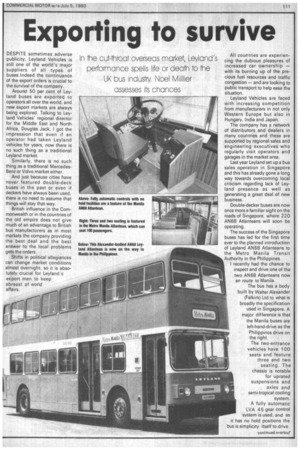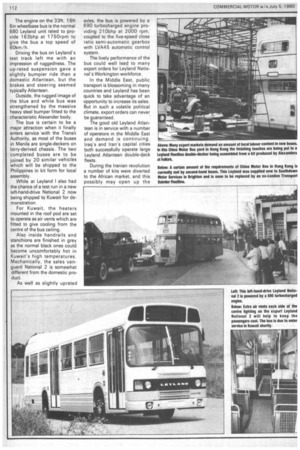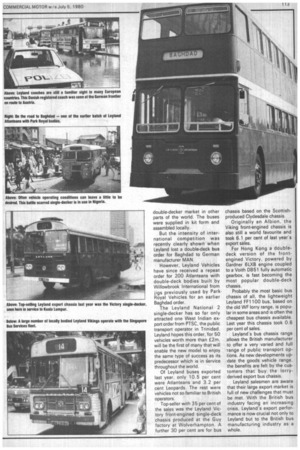Exporting to survive
Page 113

Page 114

Page 115

If you've noticed an error in this article please click here to report it so we can fix it.
In the cut-throat overseas mar,et, Leyland's performance spells life or cean to the UK bus indus-ry. Noel 1Vililier assesses its chances
DESPITE sometimes adverse publicity, Leyland Vehicles is still one of the world's major suppliers of all types of busesindeed the continuance of the export orders is crucial to the survival of the company.
Around 50 per cent of Leyland buses are exported to operators all over the world, and new export markets are always being explored. Talking to Leyland Vehicles' regional director for the Middle East and North Africa, Douglas Jack, I got the impression that even if an operator had taken Leyland vehicles for years, now there is no such thing as a traditional Leyland market.
Similarly, there is no such thing as a traditional MercedesBenz or Volvo market either.
And just because cities have never featured double-deck buses in the past or even if deckers have always been used, there is no need to assume that things will stay that way.
British influence in the Commonwealth or in the countries of the old empire does not give much of an advantage to British bus manufacturers as in most markets the company providing the best ,deal and the best answer to the local problems gets the orders.
Shifts in political allegiances can change market conditions almost overnight, so it is absolutely crucial for Leyland's export men to keep abreast of world affairs. All countries are experien cing the dubious pleasures of increased car ownership — with its burning up of the precious fuel resources and traffic congestion — and are looking to public transport to help ease the situation.
Leyland Vehicles are faced with increasing competition from manufacturers in not only Western Europe but also in Hungary, India and Japan.
The company has a network of distributors and dealers in many countries and these are supported by regional sales and engineering executives who regularly visit operators and garages in the market area.
Last year Leyland set up a bus sales operation in Singapore and this has already gone a long way towards overcoming local criticism regarding lack of Leyland presence as well as generating a great deal of new business.
Double-decker buses are now once more a familiar sight on the roads of Singapore, where 220 AN68 Atlanteans will soon be operating.
The success of the Singapore buses has led for the first time ever to the planned introduction of Leyland AN68 Atlanteans to the Metro Manila Transit Authority in the Philippines.
I recently had the chance to inspect and drive one of the two AN68 Atlanteans now en route to Manila.
The bus has a body built by Walter Alexander (Falkirk) Ltd to what is broadly the specification used in Singapore. A major difference is that the Manila buses are left-hand-drive as the Philippinos drive on the right.
The two-entrance vehicles have 100 seats and feature three and two seating. The chassis is notable for uprated suspensions and axles and semi-tropical cooling system.
A fully automatic LVA 45 gear control system is used, and as it has no hold positions the bus is simplicity itself to drive. The engine on the 33ft, 18ft 6in wheelbase bus is the normal 680 Leyland unit rated to provide 163bhp at 1750rpm to give the bus a top speed of 60km /h.
Driving the bus on Leyland's test track left me with an impression of ruggedness. The up-rated suspension gave a slightly bumpier ride than a domestic Atlantean, but the brakes and steering seemed typically Atlantean.
Outside, the rugged image of the blue and white bus was strengthened by the massive heavy steel bumper fitted to the characteristic Alexander body.
The bus is certain to be a major attraction when it finally enters service with the Transit Authority, as most of the buses in Manila are single-deckers on lorry-derived chassis. The two completed buses are to be joined by 20 similar vehicles which will be shipped to the Philippines in kit form for local assembly.
While at Leyland I also had the chance of a test run in a new left-hand-drive National 2 now being shipped to Kuwait for demonstration.
For Kuwait, the heaters mounted in the roof pod are set to operate as air vents which are fitted to give cooling from the centre of the bus ceiling.
Also inside handrails and stanchions are finished in grey as the normal black ones could become uncomfortably hot in Kuwait's high temperatures. Mechanically, the sales vanguard National 2 is somewhat different from the domestic product.
As well as slightly uprated axles, the bus, is powered by a 690 turbocharged engine providing 210bhp at 2000 rpm, coupled to the five-speed close ratio semi-automatic gearbox with LVA45 automatic control system.
The lively performance of the bus could well lead to many export orders for Leyland National's Workington workforce.
In the Middle East, public transport is blossoming in many countries and Leyland has been quick to take advantage of an opportunity to increase its sales. But in such a volatile political climate, export orders can never be guaranteed.
The good old Leyland Atlantean is in service with a number of operators in .the Middle East and demand is continuing. Iraq's and Iran's capital cities both successfully operate large Leyland Atlantean double-d,eck fleets.
During the Iranian revolution a number of kits were diverted to the African market, and this possibly may open up the double-decker market in other parts of the world. The buses were supplied in kit form and assembled locally.
But the intensity of international competition was recently clearly shown when Leyland lost a double-deck bus order for Baghdad to German manufacturer MAN.
However, Leyland Vehicles have since received a repeat order for 200 Atlanteans with double-deck bodies built by Willowbrook International from jigs previously used by Park, Royal Vehicles for an earlier Baghdad order.
The Leyland National 2 single-decker has so far only attracted one West Indian export order from PTSC, the public transport operator in Trinidad. Leyland hopes this order, for 50 vehicles worth more than E2m, will be the first of many that will enable the new model to enjoy the same type of success as its predecessor which is in service throughout the world.
Of Leyland buses exported last year, only 10.5 per cent were Atlanteans and 3.2 per cent Leopards. The rest were vehicles not so familiar to British operators.
Top-seller with 35 per cent of the sales was the Leyland Victory front-engined single-deck chassis produced at the Guy factory at Wolverhampton. A further 30 per cent are for bus chassis based on the Scottishproduced Clydesdale chassis.
Originally an Albion, the Viking front-engined chassis is also still a world favourite and took 6.1 per cent of last year's export sales.
For Hong Kong a doubledeck version of the frontengined Victory, powered by Gardner 6LXB engine coupled to a Voith D851 fully automatic gearbox, is fast becoming the most popular double-deck chassis.
Probably the most basic bus chassis of all, the lightweight Leyland FF1100 bus, based on the old WF lorry range, is popular in some areas and is often the cheapest bus chassis available. Last year this chassis took 0.6 per cent of sales.
Leyland's bus chassis range allows the British manufacturer to offer a very varied and full range of public transport options. As new developments update the goods vehicle range, the benefits are felt by the customers that buy the lorryderived export bus chassis.
Leyland salesmen are aware that their large export market is full of new challenges that must be met. With the British bus industry facing an increasing crisis, Leyland's export performance is now crucial not only to Leyland but to the British bus manufacturing industry as a whole.












































































































































































































